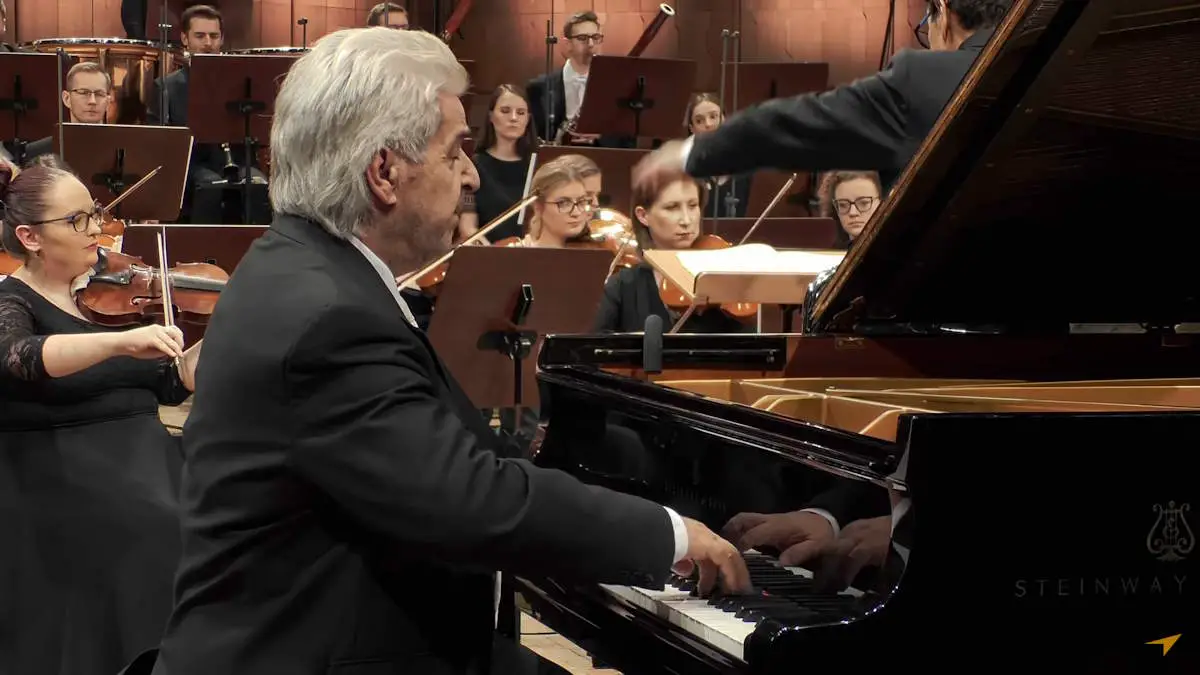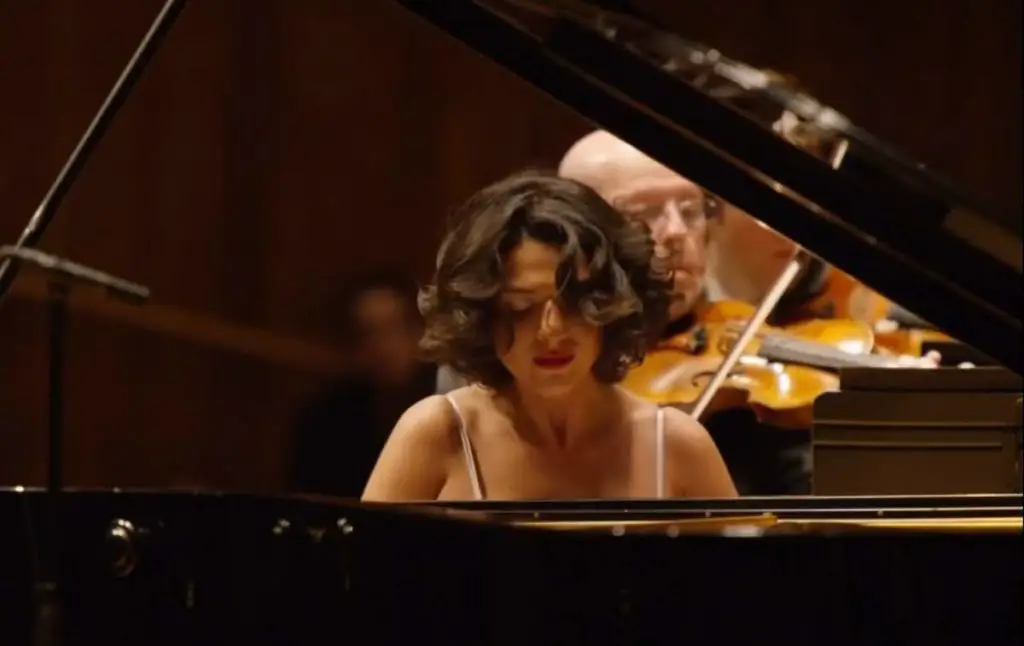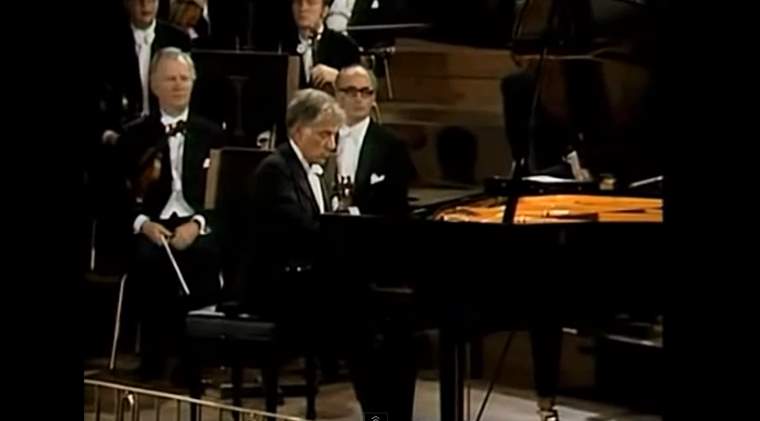Accompanied by the Pan-European Philharmonia, the Cypriot-born British pianist Marios Papadopoulos performs Ludwig van Beethoven’s Piano Concerto No. 1 in C major, Op. 15. Conductor: Peter Tiboris. Recorded at the Witold Lutosławski Concert Studio of Polish Radio on March 23, 2023. Encore: Für Elise.
Ludwig van Beethoven’s Piano Concerto No. 1
Ludwig van Beethoven’s Piano Concerto No. 1 in C Major, Op. 15, is a seminal work in the classical music repertoire, showcasing the composer’s early yet innovative approach to the concerto form. Despite being designated as his first piano concerto, it was actually composed after what is known as the Piano Concerto No. 2 in B-flat major. The reason for the reversal in numbering is that Beethoven chose to publish the C Major concerto later, considering it a more mature and sophisticated work suitable for his public debut in Vienna in the late 1790s.
The concerto reflects Beethoven’s deep respect for and influence by the works of Mozart and Haydn, yet it also displays Beethoven’s unique voice and the beginnings of his push toward the Romantic style. It is characterized by its bold use of the orchestra, innovative structure, and the demanding virtuosity required from the soloist. The concerto blends classical forms with Beethoven’s own dynamic contrasts, expansive themes, and the dramatic interplay between the piano and orchestra.
Beethoven’s Piano Concerto No. 1 was a bold statement of his skills both as a composer and as a pianist. It was designed to showcase his abilities to the Viennese audience, featuring a wide range of piano techniques and a significant role for the piano, which converses, competes, and cooperates with the orchestral parts throughout the work.
The concerto was well received, marking Beethoven’s successful entry into Vienna’s musical life and establishing his reputation as a leading pianist and composer. It has since become a staple of the piano concerto repertoire, celebrated for its lyrical melodies, structural clarity, and the emotional depth of its musical ideas. Beethoven’s Piano Concerto No. 1 is a testament to his transitional style, bridging the Classical and Romantic eras, and it remains a favorite among pianists, conductors, and audiences around the world for its expressive richness and technical demands.
Movements
With the start times in the video above:
- 00:00 Allegro con brio
- 19:43 Largo
- 32:13 Rondo. Allegro scherzando
- 43:28 Bagatelle No. 25 in A minor “Für Elise”
1. Allegro con brio
The first movement of Beethoven’s Piano Concerto No. 1 in C Major, Op. 15, is marked “Allegro con brio” and is a brilliant display of classical concerto form infused with Beethoven’s innovative ideas. This movement is structured in the traditional sonata-allegro form, which was common in the classical period, consisting of an exposition, development, and recapitulation, along with a cadenza for the soloist.
The movement begins with the orchestra introducing the main thematic material, presenting a series of bold, energetic themes that set the stage for the entire concerto. This opening is characterized by its grandeur and the clarity of the orchestral voices, laying down a rich harmonic and rhythmic foundation that Beethoven exploits throughout the movement.
After the orchestral introduction, the piano enters, taking up the themes introduced by the orchestra but quickly moving into virtuosic passages that showcase the soloist’s skill. The piano part is both demanding and expressive, with rapid scales, arpeggios, and trills, as well as more lyrical sections that provide contrast to the opening energy.
The development section sees Beethoven exploring and manipulating the thematic material, moving through various keys and showcasing his mastery of form and harmony. This section builds tension, with the piano and orchestra engaging in a dynamic dialogue that highlights the composer’s ability to create drama and complexity within the classical structure.
The recapitulation brings back the main themes, now enriched and transformed by their journey through the development. The movement typically includes a cadenza near the end, which is a solo passage where the pianist has the opportunity to display their technical and expressive abilities without orchestral accompaniment. Beethoven wrote several cadenzas for this concerto, and performers often choose one based on their personal preference or sometimes opt for cadenzas written by other composers or even their own.
The movement concludes with a return to the energetic and joyful mood of the beginning, leading to a triumphant and satisfying close. Overall, the first movement of Beethoven’s Piano Concerto No. 1 is a work of dramatic contrasts, combining classical elegance with the composer’s signature innovations, resulting in a piece that is both challenging and rewarding for performers and deeply engaging for audiences.
2. Largo
The second movement of Beethoven’s Piano Concerto No. 1 in C Major, Op. 15, marked “Largo,” is a profound and introspective contrast to the vibrant energy of the first movement. This movement is set in the key of A-flat major, which creates a warm and lyrical atmosphere distinct from the bright and assertive C major of the opening Allegro con brio.
Characterized by its slow tempo and expressive depth, the Largo is a showcase for Beethoven’s lyrical writing and his ability to craft music of intimate emotion and beauty. The movement opens with a soft, delicate orchestral introduction, setting a serene and contemplative mood. This serves as a backdrop for the entrance of the piano, which introduces the main theme—a melody of exquisite simplicity and elegance.
The interplay between the piano and orchestra in this movement is more subdued and cooperative than in the first movement, with the orchestra providing gentle accompaniment to the piano’s lyrical expressions. The strings, woodwinds, and horns all contribute to the rich tapestry of sound that supports the piano’s melodic lines, creating moments of tender beauty and emotional depth.
Beethoven’s use of variation within the Largo adds to its expressive range, as the main theme is explored and developed through different harmonies, textures, and dynamics. The piano weaves through a series of variations on the theme, each one highlighting a different aspect of the melody’s character and the soloist’s interpretative abilities.
Despite its overall tranquility, the movement is not without moments of tension and release, which Beethoven masterfully integrates to enhance the emotional landscape. The Largo concludes with a return to the tranquil mood of the opening, gently leading the listener toward the resolution and preparing for the transition to the final movement.
3. Rondo. Allegro scherzando
The third movement of Beethoven’s Piano Concerto No. 1 in C Major, Op. 15, marked “Rondo: Allegro scherzando,” serves as a lively and spirited finale to the concerto. This movement is characterized by its playful and energetic nature, embodying the rondo form that Beethoven favored for the concluding movements of his concertos. The rondo form typically features a recurring main theme (the “refrain”) that alternates with contrasting sections (the “episodes”), creating a structure that allows for both thematic cohesion and variety.
The movement opens with the orchestra introducing the main rondo theme, a catchy and rhythmic melody that sets a jubilant tone. The piano quickly takes up this theme, elaborating on it with virtuosic flourishes and bringing its own dynamic energy to the forefront. The interplay between the solo piano and the orchestra is more playful and dialogic here, with the piano often leading the charge in the thematic development and the orchestra responding in kind.
Throughout the movement, Beethoven introduces a series of contrasting episodes that explore different moods and keys, providing a rich tapestry of musical ideas and textures. These episodes allow for moments of lyrical beauty, harmonic exploration, and rhythmic variation, showcasing the composer’s mastery of form and his ability to keep the listener engaged and entertained.
One of the hallmarks of this movement is its virtuosity and the technical demands it places on the soloist. The piano part is filled with rapid scales, arpeggios, and trills, requiring precision and agility. Yet, despite the technical challenges, the movement exudes a sense of joy and playfulness, with the soloist and orchestra engaging in a spirited musical conversation.
The movement builds towards a thrilling conclusion, with the main theme returning in a triumphant and exuberant final statement. The energy and momentum increase, leading to a dazzling finish that caps off the concerto with a sense of exhilaration and jubilation.
Marios Papadopoulos
Marios Papadopoulos MBE, born on December 20, 1954, in Limassol, Cyprus, is a distinguished Cypriot-born British conductor and pianist, best known as the founder and music director of the Oxford Philharmonic Orchestra, the Orchestra in Residence at the University of Oxford.
Beginning piano at age 5, he moved to the UK in 1967 for further musical education under Ilona Kabos and Gina Bachauer. By 14, he had already received the ARCM Diploma from the Royal College of Music and made his debut with the Royal Philharmonic Orchestra at the Royal Festival Hall. His early career saw him winning a prize in the Greater London Arts Association’s Young Musicians Scheme and performing at the Bath International Music Festival on Sir Michael Tippett’s invitation.

Papadopoulos made a significant impact with his 1974 London debut, earning high praise and being described as having “all the attributes of one of the world’s greatest players.” He has since enjoyed an international career, both as a soloist and conductor, collaborating with renowned artists across the globe.
In 1998, he founded the Oxford Philharmonic Orchestra, directing multiple complete cycles of Mozart Piano Concertos and Beethoven symphonies and Piano Concertos, with his efforts recognized through various awards, including an MBE for services to music in Oxford. His contributions to music also extend to guest conducting, appearances with prestigious orchestras worldwide, and involvement in significant music competitions and educational roles within Oxford University.
Sources
- Piano Concerto No. 1 (Beethoven) on Wikipedia
- Piano Concerto No.1, Op.15 (Beethoven, Ludwig van) on the International Music Score Library Project website



